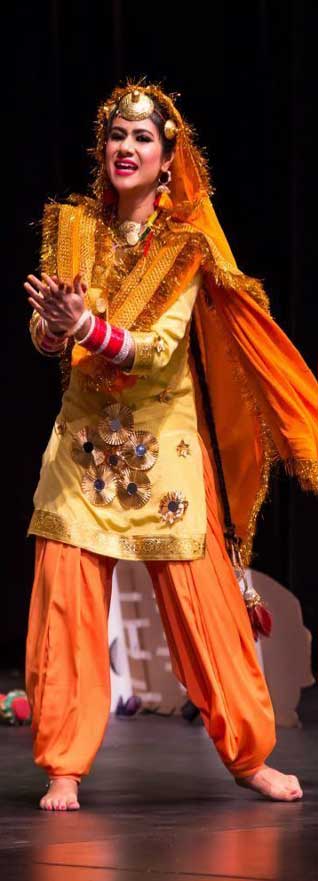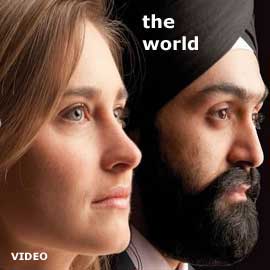Film/Stage
Bhangra:
More Than Just a Dance
DIAMOND BRIDGES
“Dancing bhangra is very joyful overall; if you’re in a bad mood, it lifts your spirits …”The music begins to play as people dressed in bright red, blue and green clothing, gather on stage, ready for the first note to hit. Fast paced drumming plays as the performers dance to match the intense speed. Their arms are widely spread out and they lift their legs up high to the point that their feet are barely touching the ground.
But despite using so much energy, everyone has big smiles and not a semblance of exhaustion on their faces.
This energetic dance is called Bhangra, which is a traditional folk dance of people from Punjab, a region that extends on both sides of the India-Pakistan border. Typically, this cultural dance would be used to celebrate the harvest season, but over the years the dance has evolved and has incorporated more modern styles. The dance had even made its way into the world’s popular films today.
Ashna Rana, the current President of Stony Brook University Bhangra, taught herself how to do bhangra by watching videos of dance teams on YouTube back in middle school.
“I just loved the music, the energy and the culture even though I wasn’t Punjabi myself,” Rana said. “I’ve come to understand the folk and rural origins of bhangra, and how the dance was born [from] the lifestyle of the farmers of Punjab celebrating each harvest.”
Even though bhangra is a representation of the Punjab culture, you do not have to be Punjabi to learn the dance. SBU Bhangra only has two members who are Punjabi descent, and the rest of the team are from various backgrounds.
“Dancing bhangra is very joyful overall; if you’re in a bad mood, it lifts your spirits, and I have such a great time,” said Yasha Pandohie, a member of SBU Bhangra.
Pandohie, who is also not Punjabi, always loved dancing but really wanted to learn bhangra.
“Before I first joined them, I thought not being a Punjabi would be a problem, but everyone welcomed me with open arms and they’re really friendly,” she noted.
The team sold out tickets for their annual Punjabi Mela on April 6. It was a celebration of Sikh and Punjabi culture through food and music, where everyone of different cultures was welcomed to immerse in the event and culture.
Sahiba Kaur, a Sikh whose family hails from Punjab, has a strong connection to the dance as it played an integral part of her life, from family parties to weddings.
“I’ve spread my culture to a huge audience who has been extremely appreciative and encouraging to our community,” says Sahiba Kaur who is instrumental in SBU Bhangra.
Traces of modern bhangra can be shown in records from the late 1800s. The music that typically goes along with this fast-paced dance style is Punjabi Boliyan lyrics which sometimes describes a specific emotion, such as love, and is supported by instrumentals like a dhol drum, which is a large wooden barrel drum, as well other musical instruments.
The dancers are dressed in beautiful garments, otherwise known as vardiyan. Men and women have different outfits they wear, but most of the clothing fit very loosely on them so that it is easier to move while dancing. But there are times where some women do wear their male counterparts version of vardiyan.
“Every time I put on the vardi [uniform] I feel like royalty, [and] that I’m dancing to represent something bigger than me,” Sahiba says.
As the strong beats of the drums continue, the movements of each of the dancers’ clothing move along with them. Jumping with one foot in the air as they turn during the routine, shows the level of skill and how much practice they put into each step, making it look flawless. The difficulty of the dance can even be shown as they sometimes dance with props in their hands, but confidence in their abilities are shown on their face.
“I remember being so tired, because we practiced over 15 hours just in those past five days [since] this was one of our largest events of the year, and we wanted our team looking nothing less of perfect,” Rana said when asked about their event, Punjabi Mela (Fest). “But seeing 350 people staring at me gave me this unbelievable rush of energy; I’m still trying to understand how I was able to perform that six and half minute energy-filled set.”
Bhangra has definitely made in its way westward, and many teams have been formed and even participate in competitions across North America.
“Bhangra has been growing more recently in America, and has been gaining a lot of attention across schools and national teams,” Shivani Majmudar, a member of the team, said. In recent years, there has been a fusion of traditional Bhangra music with more western pop music which gives the performance a modern twist to it.
However, there has been controversy over the changes made to bhangra, as some people fear it is straying away from its traditional roots too much. On the other hand, others can agree that the dance style has changed over the course of history and should be allowed to continue to adapt as time changes.
“The most important element of it all is respect,” Rana said. “We all acknowledge the foundation of bhangra and its origins in Sikh and Punjabi culture, and we try to educate those that take interest in bhangra as well so that the flow of information and education continues.”
Many teams have respect for their variety of individual styles of bhangra, whether it is more modern or traditional or even both on the spectrum. Competitions even accommodate these styles through offering different categories to participate and compete in. But all dancers can agree that bhangra presents power, energy and grace.
“You might be exhausted, but when you see the crowd and all those faces just in pure awe; that’s what makes you finish your dance and that’s when you realize the power of bhangra,” Sahiba adds.
The sense of pride when dancing bhangra is not only an emotion felt by the members of SBU Bhangra, but also seen in their performance.
“Each move in bhangra has a special meaning and every time I dance I feel like I’m in the farms and fields of Punjab, representing my Sikh and Punjabi culture to the best that I can,” Sahiba explains.
[Courtesy: Stony Brook Independent. Edited for sikhchic.com]
May 3, 2018



